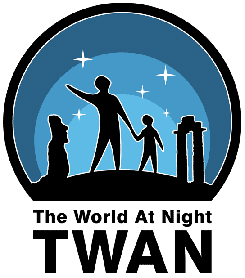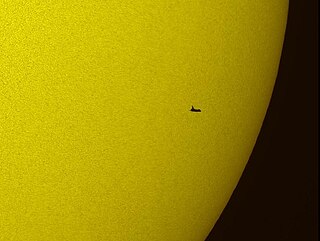
Aquarius is an equatorial constellation of the zodiac, between Capricornus and Pisces. Its name is Latin for "water-carrier" or "cup-carrier", and its old astronomical symbol is (♒︎), a representation of water. Aquarius is one of the oldest of the recognized constellations along the zodiac. It was one of the 48 constellations listed by the 2nd century astronomer Ptolemy, and it remains one of the 88 modern constellations. It is found in a region often called the Sea due to its profusion of constellations with watery associations such as Cetus the whale, Pisces the fish, and Eridanus the river.

The Eskimo Nebula, also known as the Clown-faced Nebula, Lion Nebula, or Caldwell 39, is a bipolar double-shell planetary nebula (PN). It was discovered by astronomer William Herschel in 1787. The formation resembles a person's head surrounded by a parka hood. It is surrounded by gas that composed the outer layers of a Sun-like star. The visible inner filaments are ejected by a strong wind of particles from the central star. The outer disk contains unusual, light-year-long filaments.

The Apache Point Observatory is an astronomical observatory located in the Sacramento Mountains in Sunspot, New Mexico, United States, approximately 18 miles (29 km) south of Cloudcroft. The observatory is operated by New Mexico State University (NMSU) and owned by the Astrophysical Research Consortium (ARC). Access to the telescopes and buildings is private and restricted.

Astronomy Picture of the Day (APOD) is a website provided by NASA and Michigan Technological University (MTU). According to the website, "Each day a different image or photograph of our universe is featured, along with a brief explanation written by a professional astronomer." The photograph does not necessarily correspond to a celestial event on the exact day that it is displayed, and images are sometimes repeated. However, the pictures and descriptions often relate to current events in astronomy and space exploration. The text has several hyperlinks to more pictures and websites for more information. The images are either visible spectrum photographs, images taken at non-visible wavelengths and displayed in false color, video footage, animations, artist's conceptions, or micrographs that relate to space or cosmology. Past images are stored in the APOD Archive, with the first image appearing on June 16, 1995. This initiative has received support from NASA, the National Science Foundation, and MTU. The images are sometimes authored by people or organizations outside NASA, and therefore APOD images are often copyrighted, unlike many other NASA image galleries.

The Lagoon Nebula is a giant interstellar cloud in the constellation Sagittarius. It is classified as an emission nebula and as an H II region.
Terence Dickinson was a Canadian amateur astronomer and accomplished astrophotographer who lived near Yarker, Ontario, Canada. He was the author of 14 astronomy books for both adults and children. He was the founder and former editor of SkyNews magazine. Dickinson had been an astronomy commentator for Discovery Channel Canada and taught at St. Lawrence College. He made appearances at such places as the Ontario Science Centre. In 1994, the International Astronomical Union committee on Minor Planet Nomenclature named asteroid 5272 Dickinson in honour of his “ability to explain the universe in everyday language.”
Martin P. Mobberley is a British amateur astronomer, author, and former electronics engineer.
Astronomy Now is a monthly British magazine on astronomy and space. According to the Royal Astronomical Society, Astronomy Now is the "principal amateur astronomy magazine in Britain" with a reputed circulation of 24,000.
The Association of Lunar and Planetary Observers is an international scientific and educational organization established in March 1947 in the United States by Walter H. Haas, and later incorporated in 1990. ALPO is an organization for advancing and conducting astronomical work by both professional and amateur astronomers who share an interest in Solar System observations. It is currently headquartered in Springfield, Illinois.

Stuart Nigel Henbest is a British astronomer and science communicator. Born in Manchester and educated in Belfast and at Leicester University, Henbest researched in radio astronomy at the University of Cambridge before becoming a freelance author, television producer and astronomy lecturer. Asteroid 3795 Nigel is named after him.

David John Eicher is an American editor, writer, and popularizer of astronomy and space. He has been editor-in-chief of Astronomy magazine since 2002. He is author, coauthor, or editor of 23 books on science and American history and is known for having founded a magazine on astronomical observing, Deep Sky Monthly, when he was a 15-year-old high school student.

Comet Lulin is a non-periodic comet. It was discovered by Ye Quanzhi and Lin Chi-Sheng from Lulin Observatory. It peaked in brightness at magnitude between +4.5 and +5, becoming visible to the naked eye, and arrived at perigee for observers on Earth on February 24, 2009, and at 0.411 AU from Earth.

The World At Night (TWAN) is an international project to produce and present a collection of high-quality photos, videos, and virtual reality (VR) images of the night sky taken at various natural, cultural, and historic locations worldwide.

Rogelio Bernal Andreo is a Spanish-American astrophotographer. He is known for his photographs of deep sky objects. His work has been recognized by NASA as a regular contributor to their Astronomy Picture of the Day (APOD) 80 times. Andreo's photography has been published in international magazines and periodicals, as well as television networks including the BBC, National Geographic, and the Discovery Channel series Into the Universe with Stephen Hawking.
Robert J. Nemiroff is an Astrophysicist and Professor of Physics at Michigan Technological University. He received his Ph.D. from the University of Pennsylvania in Astronomy and Astrophysics in 1987 and his B.S. from Lehigh University in Engineering Physics in 1982. He is an active researcher with interests that include gamma-ray bursts, gravitational lensing, and cosmology, and is the cofounder and coeditor of Astronomy Picture of the Day (APOD), the home page of which receives over a million hits a day, approximately 20% of nasa.gov traffic. He is married and has one daughter.

Astronomy Photographer of the Year is an annual astronomy photography competition and exhibition that is organised by the Royal Observatory, Greenwich.

Thierry Legault is a French amateur astronomer, specializing in astrophotography.

Petr Horálek is a Czech astrophotographer, popularizer of astronomy and an artist.

Emma J. Bunce is a British space physicist and Professor of Planetary Plasma Physics at the University of Leicester. She holds a Royal Society Wolfson Research Merit Award. Her research is on the magnetospheres of Saturn and Jupiter. She is principal investigator (PI) of the MIXS instrument on BepiColombo, was deputy lead on the Jupiter Icy Moons Explorer proposal, and co-investigator on the Cassini–Huygens mission.
















